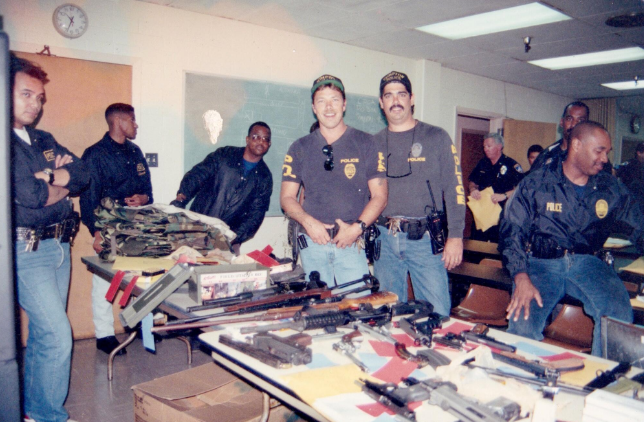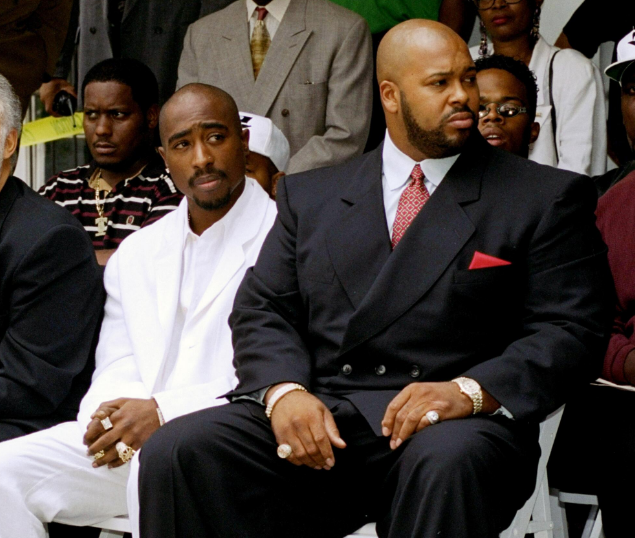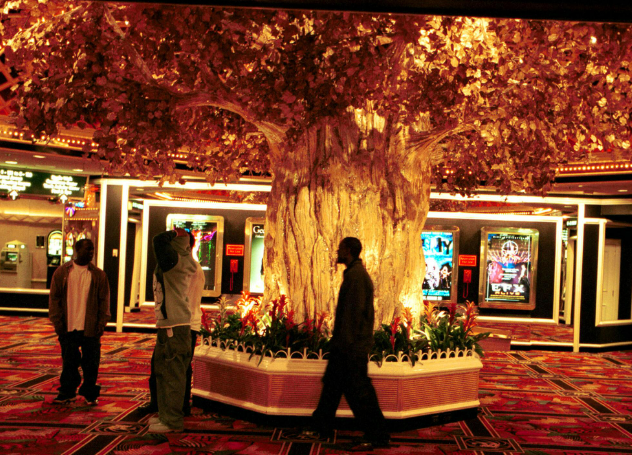Tupac Shakur was killed in Las Vegas, but it was in Compton — home to both the rapper’s allies and his accused killers — where the aftershocks erupted.
They started two days after Shakur was fatally shot the night of Sept. 7, 1996, when someone opened fired from a gray sedan with tinted windows and chrome rims on Alondra Boulevard, hitting a leader of a local Crip gang — as well as a 10-year-old girl.
So began “the 10 days of hell,” said Robert Ladd, a former Compton detective who investigated Shakur’s death and the retaliatory killings that spiraled from it. By its end, three people were dead and 10 were wounded.
Solving Shakur’s killing was not the responsibility of the Compton police.
But as detectives investigated the back-and-forth shootings that stemmed from it in their own city, they quickly pieced together — through informants, field interviews and seizures of firearms and other evidence — a remarkably prescient account of why the rapper was killed and who was behind it.
Compton detectives laid out their findings in an affidavit that authorized them to search 38 homes and apartments in Compton, Long Beach, Lynwood, Downey, Paramount and Lakewood.
Tim Brennan, left, and Robert Ladd, right, detectives for the Compton Police Department, served a search warrant on Oct. 2, 1996, that targeted various gang members believed to be on either side of a war that broke out after Tupac Shakur was killed.
(Courtesy of Robert Ladd)
The document, written just 18 days after Shakur was shot, proved to be a road map for the Las Vegas investigation, which would drag on for the next 27 years while the rapper’s death became the subject of endless books, documentaries and conspiracy theories.
“We knew things would play out sooner or later. I just didn’t think it would take 26, 27 years,” Ladd said.
The affidavit shows that within five days of Shakur’s shooting, Compton police heard from an informant a story nearly identical to the account given by Las Vegas prosecutors last month in announcing that a suspect — a well-known Compton gang member named in the 1996 affidavit — had at last been arrested in the rapper’s death.
Far from the sinister and complex plots that have filled the vacuum of credible information about Shakur’s death, it is a story that is simple and petty and short: A necklace snatched in a suburban shopping mall. A beat-down in a casino lobby. Payback delivered from a gun extended from a rented Cadillac’s window.
With the exception of Shakur himself, every player involved in the rapper’s death was from Compton. Marion “Suge” Knight, who signed Shakur to his label, Death Row Records, grew up in the city and surrounded himself with members of a local Bloods gang, Mob Piru.
In 1996, Compton’s 10 square miles were divided among 55 gangs, said Ladd, who along with his partner, Tim Brennan, wrote a book about the 15 years they spent on the police force called “Once Upon a Time in Compton.” They patrolled the city until Compton disbanded its police department in 2000 in favor of contracting with the Los Angeles County Sheriff’s Department.
“There wasn’t one residential street in Compton that wasn’t claimed by a gang,” Ladd told The Times. Compton was a more violent place then, recording 70 to 80 homicides a year, he said. In 2022, by comparison, the Sheriff’s Department’s Compton station saw 16 killings in the city and surrounding unincorporated areas.
Even in a city where death came easily and often, the violence that followed Shakur’s killing was startling. Two days after he was shot, Darnell Brim, a senior member of the Southside Crips, was shot in the back on Alondra Boulevard in Compton, Brennan wrote in the search warrant affidavit. A 10-year-old girl was also struck by gunfire and was seriously wounded.
The next day, a member of Leuders Park Piru, a Bloods gang aligned with Mob Piru, was shot on Bradfield Street. The gunman, who opened fire from a blue Chevrolet Blazer, was said by informants to be a Southside Crip, Brennan wrote. Later that day on the same street, a man whose brother worked as a security guard for Death Row Records was shot by someone who fired from a red Nissan.
To Ladd, it was clear that the Southside Crips — blamed for Shakur’s shooting — were retaliating against Piru gangs affiliated with Knight and his record label. “Why else would they be going to war?” he said.
The Southside Crips claimed a swath of Compton bounded by Alondra Boulevard to the north, Greenleaf Boulevard to the south, Long Beach Boulevard to the east and Santa Fe Avenue to the west.
“They were one big happy family at one time,” Ladd said.
Then a schism opened between two crews, both named after the streets where most of their members grew up. On one side was the Glencoe crew and on the other, the Burris crew led by Duane “Keefe D” Davis.
Duane Davis, shown in an undated photo, was a longtime member of the Southside Crips in Compton. He is charged with the murder of Tupac Shakur.
(Robert Ladd)
Ladd watched Davis go from “just a gang banger hanging out in the street” to one of the biggest dealers of rock cocaine in Compton after getting out of prison, he said, where Davis had made connections with drug suppliers.
The same day the two Bloods were shot on Bradfield Avenue, an informant told Compton police that a man had delivered a duffel bag of guns to a complex on Glencoe Avenue that the Southside Crips used as a safe house, Brennan wrote. The source said the gang members had told residents to stay indoors because “it’s on.”
When police searched the duplex that night, they found an assault rifle, two handguns, seven ski masks, a box of .40-caliber ammunition and a duffel bag with a Southwest Airlines baggage tag that listed a Las Vegas address.
The next morning, Bobby Finch, who grew up in the Southside Crips’ neighborhood and had friends in the gang, was killed in a drive-by on Mayo Avenue. Informants said the shooter, who fired from a Honda Civic hatchback, was a Mob Piru, Brennan wrote.
Then detectives got a tip about a car that would prove critical in the Shakur case: Jerry Bonds, a Southside Crip nicknamed Monk, had brought a rented late-model white Cadillac to an auto repair shop, the informant reported. Bonds was present when police found the guns, ski masks and duffel bag at the safe house, Brennan wrote. The tipster said the car stood out because “word on the street was that Southside Crips driving a white Cadillac were responsible for shooting Tupac Shakur in Las Vegas.”
Ladd said he and Brennan were never able to track down the Cadillac. (Bonds was gunned down at the Conga Room, a popular nightclub in L.A., in 2002.)
The next day, the Compton detectives met with another informant who drew a line from Shakur’s death to a fight that broke out about two months earlier at the Lakewood mall. The source, described by Brennan as being affiliated with the Death Row Records-Mob Piru camp, said a Mob Piru named Travon Lane was shopping at a Foot Locker when some Southside Crips confronted him and took his “Death Row” necklace.
A fight in the lobby of the MGM Grand hotel served as a catalyst in the shooting of Tupac Shakur, investigators say.

(Clarence Williams / Los Angeles Times)
The night of Sept. 7, 1996, after watching Mike Tyson knock out Bruce Seldon at the MGM, Shakur and his entourage spotted a lone Southside Crip in the casino’s lobby, the source told detectives. Lane recognized him as one of the men who stole his necklace and pointed him out to Shakur, who had recently inked “MOB” on his arm, the informant said.
According to the source, Shakur asked the man, “You from the south?” before attacking him. Several Pirus jumped in, beating the man until the hotel’s security guards broke it up.
Afterward, the Death Row entourage formed a caravan with Shakur and Knight in the lead in Knight’s black BMW and headed to a nightspot called Club 662. The numbers “6-6-2,” Brennan noted, spell out “MOB” on a telephone. While Knight and Shakur waited at a red light, a white Cadillac pulled alongside, the informant said. A man stepped out of the passenger seat “talking s—,” the source claimed, then pulled out a gun and started shooting.
That night, after Shakur and Knight were hospitalized, their entourage talked about the shooting at Club 662. Lane, the informant said, “was telling everyone that the shooter was the same person they jumped at the MGM.” Lane identified him as “Keefe D’s nephew from the Southside Crips.”
On Sept. 13, 1996, Shakur died from his wounds. At noon that day in Compton, a man armed with a revolver killed Marcus Childs and Timothy Flanagan, members of the Fruit Town and Elm Lane Piru gangs, respectively, Brennan wrote. A bystander was also wounded. Informants said the shooter was a member of either the Southside Crips or their affiliates, the Chester Street Crips.
In the next 12 hours, five people — one a Chester Street Crip — were shot and wounded, Brennan wrote. The suspects were members of the Treetop, Fruit Town, Leuders Park, Elm Lane and Cedar Block Piru gangs.
Compton police and sheriff’s deputies met with homicide detectives from Las Vegas, who showed them a videotape of the assault in the MGM’s lobby. The tape, Brennan wrote, showed Shakur, Knight and their entourage beating Orlando Anderson, a Southside Crip and nephew of Davis.
The Vegas detectives said they’d gotten anonymous phone calls saying someone called “Baby Lane” had shot Shakur. Brennan and Ladd knew this was Anderson’s nickname.
At the time, however, the Las Vegas detective leading the investigation discounted a connection between the beating and Shakur’s shooting, saying Anderson “probably didn’t even know it was Tupac Shakur” who attacked him.
A judge authorized the Compton police to search the homes of virtually everyone on either side of the Crip-Piru war. Arrested on that day in October 1996 were Anderson and two of his closest friends, DeAndre Smith and Terrence Brown.

The Vegas police sent two detectives to interview them, Ladd recalled, but they didn’t get very far. “They weren’t prepared or had the know-how to talk to gang members,” he said.
Anderson admitted being in Las Vegas the night Shakur was shot but denied having anything to do with it, Ladd said.
Ladd didn’t believe the Las Vegas police realized the significance of Shakur’s death.
“We always felt Vegas at the time was trying to become family-oriented,” he said. The city was trying to draw tourists to its casinos and families to its subdivisions — an image antithetical to out-of-town gangsters shooting it out in the street.
“They just kind of wanted it to go away,” he said. “And of course, it didn’t; in fact, it just got bigger. They didn’t realize, to me, how big Tupac really was.”
A year after Shakur was killed — and after the rapper’s mother, Afeni Shakur, filed a wrongful death suit against him — Anderson told The Times he was innocent and dismissed the Compton police investigation as “fiction.”
“I don’t own a gun and I’ve never killed anybody,” he said. “My moms didn’t raise me like that.”
Eight months later, Anderson and a friend, Michael Dorrough, spotted some members of the Corner Pocket Crips who owed him money from a drug deal at a car wash in Compton, Ladd said. When the bullets stopped flying, Anderson, 23, and Jerry Stone, 25, lay dead and Stone’s uncle, Michael Stone, 43, was fatally wounded. Dorrough was convicted of murder and is serving life in prison.
The investigation into Shakur’s death was revived in Los Angeles 10 years later, when LAPD brass set up a task force to solve the murder of another rapper.
A squad of LAPD detectives and federal agents were assigned the case of Christopher Wallace, the rapper known as the Notorious B.I.G., who was gunned down in 1997 after leaving a party at the Petersen Automotive Museum on Wilshire Boulevard. The task force never found Wallace’s killer, but it did get Davis — the Southside Crip leader who’d appeared at the peripheries of the Compton police investigation of Shakur’s murder — to talk.
LAPD Dets. Greg Kading and Daryn Dupree approached Davis in the garage of his Riverside County home in December 2008 and told him they had enough evidence of his drug dealing to send him to federal prison for 25 years, Kading recalled.
Davis agreed to sit down with the detectives and prosecutors from the U.S. attorney’s office in Los Angeles for what is called a proffer session. Davis’ words could not be used to prosecute him, the agreement went, so long as he told the truth.
Davis said his nephew shot Shakur.
“He leaned over, and Orlando rolled down the window and popped him,” he said, according to a transcript of the interview. “If they would have drove on my side, I would have popped them. But they was on the other side.”
Davis said he drew the gun used to kill Shakur, a .40-caliber Glock, from a hidden compartment in the Cadillac. Before his nephew started shooting, he said, Knight made eye contact with him. “We’ve known each other since we was 7 or 8 years old,” Davis said. “I see the bullet go in Suge’s head. I thought he was dead.”
Davis’ confession didn’t remain secret. Kading wrote a book called “Murder Rap” that publicized the account, and several documentaries made public a recording of the interview.
Ladd, the retired Compton detective, was furious when he learned Kading and federal authorities had made a deal with Davis without consulting the Las Vegas police — “a major league no-no,” he said.
“If it was my case and the FBI went behind my back and made this deal without telling me, I’d be extremely pissed off,” he said. “Actually, I’d go ape s—.”
Ladd said the task force had enough leverage with the prospect of a long stretch in prison to negotiate a guilty plea from Davis and secure his testimony against anyone else involved in Shakur’s death. After Davis admitted his role during the proffer, Ladd said, “It was like, OK, what are you going to do with it? He told you he was in the car. You gave him immunity. Good job. So now what are you going to do?”
His immunity may have ended the moment he walked out of his proffer, but for the next decade, Davis didn’t act like a man considered a prime suspect in a notorious homicide. He dove into a cottage industry of manufactured intrigue around the deaths of Shakur and Wallace, repeating the story he told detectives and prosecutors to filmmakers, bloggers, authors, journalists and seemingly anyone who would listen.
In one videotaped interview, Davis said that Brown and Smith, two Southside Crips arrested with his nephew in 1996, were also in the Cadillac the night that he said Anderson shot Shakur. Smith died of complications from obesity in 2004, and Brown was killed during a robbery of a Compton marijuana dispensary in 2015, Ladd said.
In another clip, posted in 2021 on the 25th anniversary of Shakur’s shooting, Davis said: “Suge just ducked his head and the first bullet went in his head.” Shakur, he said, “was trying to do a breakdance, trying to jump in the back seat or something. Looked like he was trying to jump up but bullets was hitting his ass.”
Kading said authorities are able to use every word Davis said outside of his proffer to convict him. “He’s the best witness against himself,” Kading said.

Ladd said he believes, at some level, the Las Vegas police were simply embarrassed into making an arrest. Between Davis moving to Nevada, writing a book called “Compton Street Legend” that detailed the Shakur murder and talking about it in YouTube videos, “he’s throwing it right in their face.”
After hearing several months of testimony, a grand jury in Las Vegas indicted Davis last month on the charge of murdering Shakur. After the 60-year-old was arrested, Chief Deputy Dist. Atty. Marc DiGiacomo told reporters a story that sounded familiar to anyone who followed the Compton police investigation some 27 years earlier.
“There was an effort to steal a Death Row chain,” DiGiacomo said.
After Lane recognized Anderson as the thief in the MGM lobby, the prosecutor said, “a giant beat-down of Mr. Anderson” ensued. A white Cadillac, with Davis in the front passenger seat, pulled alongside Knight’s black BMW.
Davis’ longtime attorney, Edi M.O.Faal, declined to comment.
Ladd testified before the Las Vegas grand jury, giving the panel a portrait of Compton’s gang dynamics at the time of Shakur’s death and an understanding of all the people involved. He wished his partner, Brennan, who died several years ago from cancer, could have lived to see the arrest of Davis.